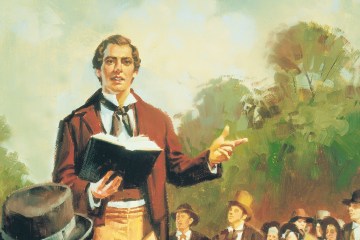Earlier this year, significant changes were made to the LDS temple endowment. As a follow-up to an earlier essay about the patriarchal theology of the endowment ritual, this essay will explore the evolution of the LDS endowment over the past 33 years regarding the covenants female patrons make.
Doctrine
Fundamentalist Misreadings of the Great Commandment
Audio and text transcript of comments made by Elder Teh, a General Authority Seventy, during the Alpine Utah Stake Conference in June 2022. Some personal commentary in reaction at the end.
In the (Quasi-Religious) Mind of a Mormon Conspiritualist
In the previous essays, we have summarized the research literature on the cognitive and behavioral correlates of conspiracy belief along three general categories—epistemic, existential, and social motives. In this essay, we will explore the functional similarities between religious and conspiracist discourse, using Mormonism as an ethnographic lens.
The Legacy of Adam-God in the Mormon Theology of Heteropatriarchy
The Adam-God doctrine may be a “deadly heresy” in the current LDS church, but ideas that have their origins in this doctrine remain at the center of Mormon theology today. Let’s discuss how current temple worship and LDS teachings/policies regarding gender and sexuality continue to be influenced by ideas initially developed as part of Young’s polygynist cosmology.
Fascinating Priesthood: Oaths and Covenants for Patriarchal Dominance
The lessons this week are focused on directing members to identify the ways they are blessed by restored priesthood authority and the rituals and ordinances pertaining thereunto. A major emphasis of the lesson materials is devoted to gender complementarianism and gaslighting women into accepting the policy of male-exclusive ordination in the LDS church.
“These are they”: Kirtland’s Expansion of the Mormon Afterlife
This week’s “Come, Follow Me” lessons cover “the Vision” of the afterlife that dramatically expanded Mormon theology in 1832. In my most detailed response on the 2021 curriculum so far, we take a close look at the historical and intellectual context of D&C § 76, and how the modern church is shifting its narrative.
No Weapon Shall Prosper: Confounding the Critics of the Church
This week’s “Come, Follow Me” lessons lead a discussion on how members should respond to critics of the church, with a reminder that its each members duty to share the gospel with their neighbors. Also discussed are the ministerial responsibilities of bishops to their wards.
Revealing the Revelations: A Reaction to Ezra Booth
The decision to publish the Book of Commandments, and the revelations produced between 1–12 Nov 1831, were all in direct response to Ezra Booth’s opposition to Smith and the church. The “Come, Follow Me” manuals ignore this context entirely, favoring instead to present a message about how awesome are God’s mouthpieces. Also, baptize your kids.
Eager and Indulgent Obedience Makes For a Joyful Parousia
This week’s “Come, Follow Me” lessons ask members to “be not weary” in offering the “heart and a willing mind” in the service of the church. Members are to “forgive everyone” or remain condemned of the greater sin. They are reminded that theirs is the responsibility of preparing the world for Christ’s return.








